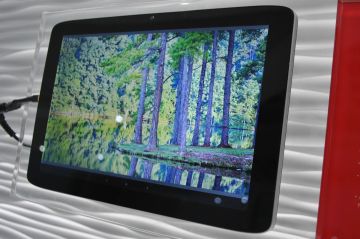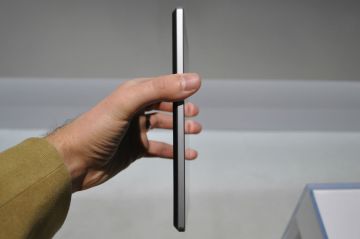Apparently Vizio didn’t get the memo that Android tablets aren’t worth making anymore. It’s planning to release two of them — one with a 10.1-inch display, the other with a 7-inch display.
Vizio’s 10.1-inch Android tablet is one of the first devices we’ve seen with an Nvidia Tegra 4 processor, with the extra graphics oomph helping to power a 2560-by-1600 resolution display. Unfortunately, we weren’t able to see what else Tegra 4 can do; Vizio’s prototype was short on software to check out, and the software hadn’t been optimized at all yet, so it was a bit choppy in its pre-launch state.

Other specs for Vizio’s 10.1-inch tablet include 32 GB of storage with a MicroSD slot for added capacity, a 5-megapixel camera in back, a 1.3-megapixel camera up front, Micro-USB and Micro-HDMI output. Although the tablet on display was clad in plastic, with sharp edges reminiscent of its thin-and-light PCs, Vizio is debating whether to use aluminum instead.
The 7-inch tablet is like a slimmer, lighter Nexus 7, with sharper edges. Its specs are nearly identical to Google‘s own Android tablet, with a 1280-by-800 resolution display, Nvidia Tegra 3 processor, 16 GB of storage and a 1.2-megapixel front-facing camera. Although Vizio hasn’t announced a final weight and thickness for its 7-inch tablet, as a Nexus 7 user I can say that Vizio’s tablet felt noticeably airier.
(MORE: What’s in the Bag, Wuss? Gearing Up for the 2013 Consumer Electronics Show)
Both tablets run an unmodified version of Android 4.1. Eagle-eyed Android fans may notice, however, that the tablets use an older style of Android tablet interface, without the app dock found in Google’s Nexus 7 and Nexus 10. Vizio Chief Technical Officer Matt McRae told me the company is still deciding whether to switch to the newer interface style.
Of course, the main problem for Vizio is the same one that’s scared off other companies, who’ve basically stopped releasing high-end tablets based on Google’s operating system: It’s not clear why you’d buy an Android tablet — even a well-built, competitively-priced one — instead of an iPad, or for that matter, instead of Google’s own Nexus 7 and Nexus 10 tablets.

Vizio thinks it has Google beat on display quality, design and, in the case of the 10-inch tablet, performance, but it’s hard to sell the mass market on minor spec differences, and Android still suffers a lack of tablet apps compared to Apple‘s iOS. Vizio hasn’t announced prices or release dates for its tablets yet, either.
Still, I’m glad there’s at least one company that’s showing off new Android tablets at CES. It seems that most other vendors have been scared off by slow sales and tough competition from devices like the Kindle Fire (which hardly resembles Android at all) and Google’s own Nexus tablets. These days, they’re placing their bets on Windows 8 instead. But if Vizio can get its prices low enough and get its products in front of shoppers at major retailers, it may have a chance to bring some life back to the Android tablet scene.
MORE: Check out TIME Tech’s complete coverage of the 2013 Consumer Electronics Show

